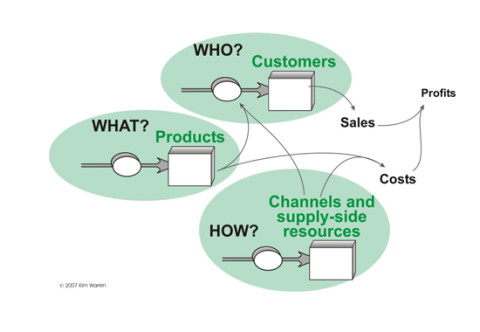Course 2: System Dynamics for Business Strategy
1. Course Description
Introduction to the system dynamics for business strategy in small medium enterprises.
Level: graduate; 10 ECTS points. The course is conducted entirely in English.
2. Learning Outcomes
Knowledge and understanding
Students are able to apply system dynamics to business strategy formulation and implementation, with a particular focus on small medium enterprises. Skills are developed in mapping processes affecting performance. Students also learn to use the system dynamics method in supporting business decision makers to identify areas for results improvement, and set proper goals/objectives, as well as performance indicators to foster sustainable strategies.
Applying knowledge and understanding
The students will engage in real life case-study analyses in which they will practice their business and modelling knowledge and understanding on identifying the systems structure underlying poor business performance and on developing and assessing strategies and policies aimed at performance improvement. Students will demonstrate their ability to transfer their skills across management disciplines, including strategic management accounting and business and scenario planning. And they learn to approach a problem from a multi-sectorial and a multi-disciplinary perspective.
Making judgements
Students learn to assess the sustainability of business strategy on different perspectives. They gain a systemic, time-related, and open-ended view of firms. They also learn to evaluate performance, based not only on financial and tangible factors, but also on intangibles. Planning & Control, Strategy & Implementation are seen on a continuum that is focused on learning. Students learn to detect the limits of mechanistic approaches in using conventional tools for strategy design and implementation, and performance evaluation. They learn how the role of such tools can be re-shaped according to a learning- oriented perspective, by using the SD method. Real case-study analysis will be conducted during lectures.
Communication
Students can present and discuss relevant literature sources as well as the result of their case studies in class. They also present results from modelling and simulation sessions to stakeholders in organizations and to interested academics.
Learning skills
Students are enabled to acquire skills – also through individual assignments (together with feedback from teachers) – that are required for self-studies of the literature on the subject.
3. Course Content
The course is divided into three parts:
- Strategy principles & Strategic planning/control
- The concept of business strategy – The Business Idea. Strategy as learning
- Strategy as learning: Case-study analysis
- Strategic Planning & Control. Conventional strategic analysis tools: matrixes, SWOT analysis
- The strategy process
- Dynamic Balanced Scorecard modelling
- Modelling strategic performance: drivers of profitability, competitive and social success
- Modelling strategic assets accumulation and depletion processes and their impact on performance drivers and outcomes
- Business Growth Sustainability & restructuring strategies
- The peculiar complexity of SMEs
- Planning for business growth and restructuring – Modelling SME Growth
- Diagnosing Business Growth Sustainability
- Modelling stunted and inflated growth
- The Dynamic Balanced Scorecard
- Modelling Intellectual Capital
- Designing & Implementing ILEs to support management education and entrepreneurship.
4. Course Design
The course is comprised of lectures, seminars, group discussions, students’ presentations, and individual assignments/papers. An overall attendance rate of 80% in scheduled sessions is required, and attendance is mandatory in the group discussions, students’ presentations, and seminars, and active participation is required in those sessions.
5. Student’s Evaluation
Assessment is carried out by using the following criteria:
- Individual/group assignment/s (students could receive one or more assignment/s during the course to be completed during classes or at home in a given time). This criteria has a 30% weigh on the final course mark.
- Final course essay. This criteria has a 40% weigh on the final course mark.
For a passing grade the student must (a) have passed marks on all the assignments; (b) have participated in the mandatory sessions; (c) have an adequate overall attendance rate.
Project work evaluation conducted during all semester (e.g., outcomes, modeling, interaction with the organization). As the project work will be carried out during the semester, this 30% evaluation will be added to all 4 courses marks.
An ECTS grade is provided to the student at the end of the course according to the A, F scale. Students not successfully fulfilling all the course requirements within the regular time frame have the option of reaching agreement with the course director of studies on how to complete the course requirements in a timely manner.
6. Course Admission Requirements
The course requires a Bachelor’s degree in any subject. The course is open to students enrolled in the Erasmus Mundus master program.
7. Literature
Bernard Marr, Dina Gray and Andy Neely, 2003, Why do firms measure their intellectual capital? Journal of Intellectual Capital Vol. 4 No. 4, p. 441-464
Bianchi C. 2002. Introducing SD modelling into planning and control systems to manage SMEs’ growth: a learning-oriented perspective, System Dynamics Review, Vol. 18, No. 3: 315–338
Bianchi C. and Bivona E., 2000. Commercial and financial policies in family firms: The Small Business Growth Management Flight Simulator, Simulation & Gaming 31: 197-229
Guerreiro, Bio, Merschmann (2008), ‘Cost to serve measurement and customer profitability analysis’, The International Journal Of Logistics Management, Volume 19 Issue 3 p. 389- 407,
Hughes, S. B. and K. A. P. Gjerde. 2003. Do different cost systems make a difference? Management Accounting Quarterly (Fall): 22-30.
Jagels Martin G.. 2006. Hospitality Management Accounting, 9th Edition, Chapter 1
Rockart John F. 1979. Chief Executives Define Their Own Data Needs, Harvard Business Review, 8192
Warren K. 2011. Challenging our slogans (working paper), 5th European System Dynamics Workshop, Frankfurt, Germany
Warren K., 1999, The Dynamics of Strategy, Business Strategy Review, 10, 3, pp 116
Warren K., 2000, The Softer Side of Strategy Dynamics, Business Strategy Review, 11, 1, pp 45-58 Warren K., 2008, Strategic Management Dynamics, John Wiley & Sons, Chichester
Additional readings will be provided during the course by Prof. Martin Schaffernicht

